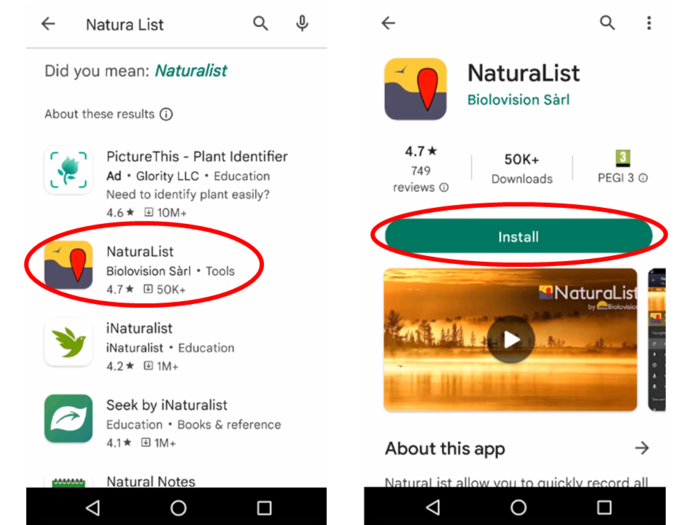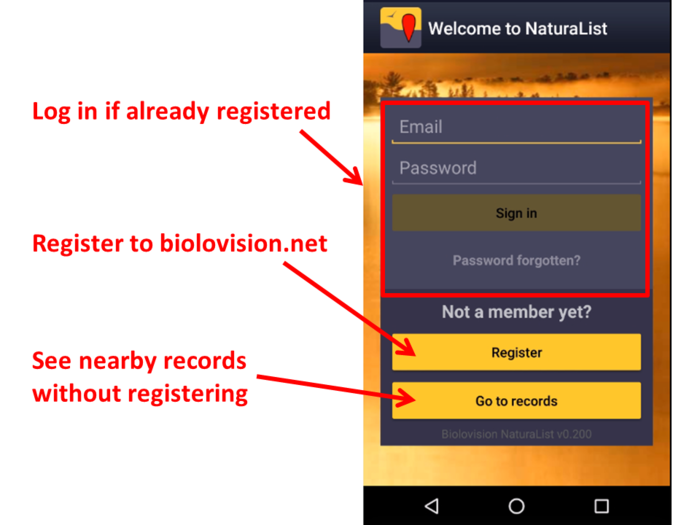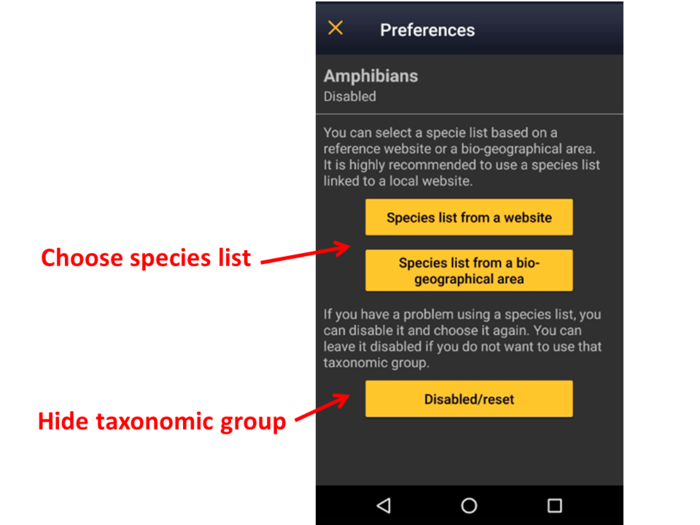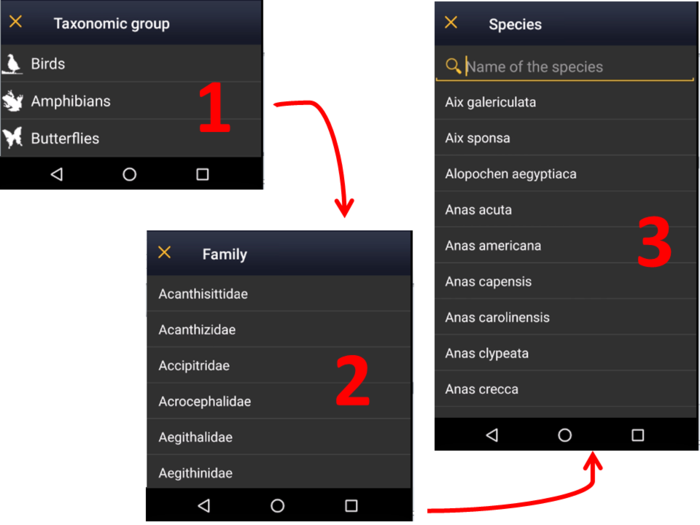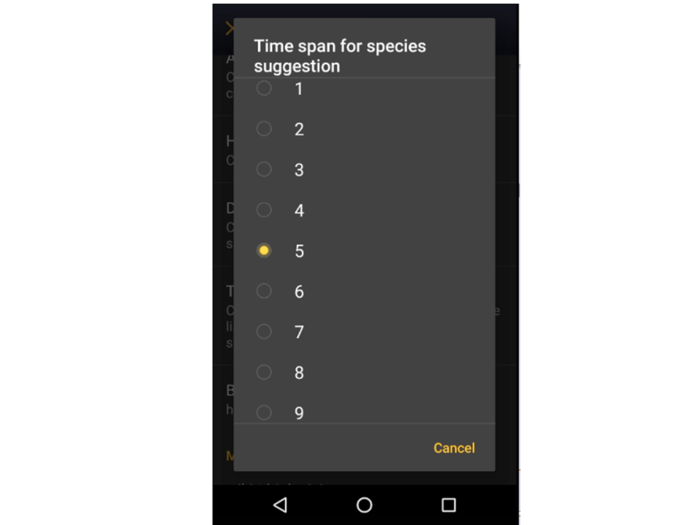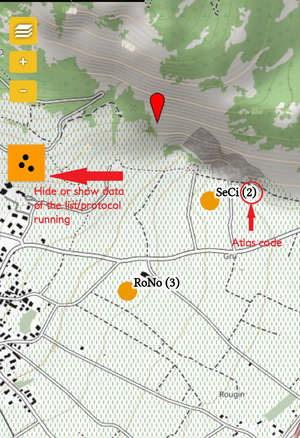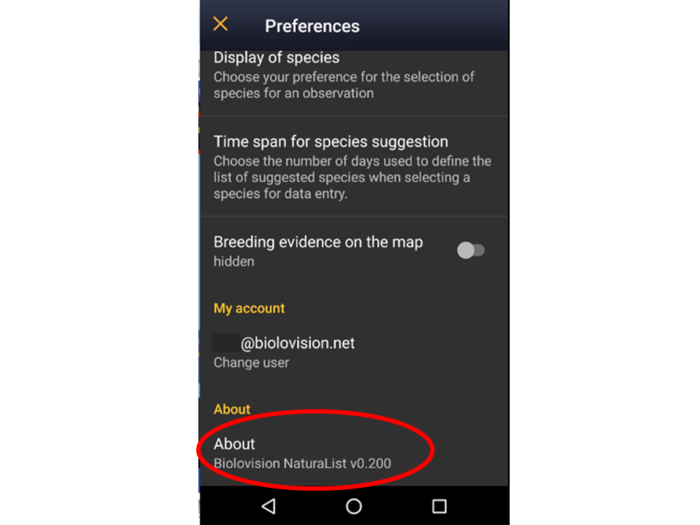Commencer avec NaturaList
NaturaLlist est une application mobile utilisable dans le monde entier qui permet de parcourir et de partager vos observations de biodiversité de manière décontractée comme un carnet de terrain, par liste ou avec des outils plus avancés pour la collecte protocolée de données..
Pour accéder à toutes les fonctions de NaturaList, vous devez être enregistré et connecté.
Les utilisateurs non enregistrés peuvent accéder aux "données autour de vous" publiques des derniers jours
Plusieurs langues sont disponibles. Vous trouverez une liste de toutes les langues disponibles dans la section wiki
Divers> Available languages.
La plupart des fonctions sont disponibles pour Android et iOS. Certains outils avancés, comme les protocoles, ne sont actuellement disponibles que sur Android. L'application NaturaList est liée à data.biolovision.net et aux portails ornitho existants (voir l'image Dataflow between our tools. Ces portails vous offrent toutes les possibilités d'utilisation, de sauvegarde et de partage de vos données après synchronisation. Voyez ce que vous pouvez faire dans chacun des "outils" dans le tableau ci-dessous. Pour voir la liste des portails locaux, visitez la section Divers> Local portals and partners.
| Fonction pour les utilisateurs inscrits | NaturaList Android | Naturalist iOS | Data.biolovision.net | Portail local |
|---|---|---|---|---|
| Entrée des données occasionnelles | OUI | OUI | NON | OUI6 |
| Entrer une liste d'informations | OUI | OUI | NON | OUI6 |
| Entrer une observation a posteriori | OUI | OUI | NON | OUI6 |
| Projets | OUI | NON | NON | OUI6 |
| Protocoles | OUI1 | NON | NON | OUI1,6 |
| Afficher les données (y. c. les données rares) | OUI | OUI | NON | OUI2,6 |
| Cartes hors-ligne | OUI | NON | NON | NON |
| Utilisation hors-ligne | OUI3 | OUI4 | NON | NON |
| Partager la position de votre observation et l'envoyer à google maps | OUI | OUI | NON | NON |
| Statistiques et autres informations | NON | NON | OUI, partly | OUI6 |
| Outil de traduction des noms d'espèces | OUI | OUI | NON | NON |
| Téléchargez vos propres données | NON | NON | OUI | OUI6 |
| Utilisation dans le monde entier | OUI | OUI | OUI | NON |
| Modifier/supprimer vos données | OUI5 | OUI5 | NON | OUI6 |
| Affichez vos données sur une carte | NON | NON | OUI | OUI6 |
| Les noms d'espèces sont disponibles dans de nombreuses langues | OUI | OUI | OUI | OUI7 |
1 Seulement pour les utilisateurs ayant des droits spéciaux. Pour en savoir plus sur les utilisateurs ayant des droits spéciaux, consultez la sectionWeb interface > Local Portals > Administration.
2 Par une recherche spécifique ou par un affichage automatique au cours des 5 derniers jours.
3 Sauf pour les données synchronisées, downloading maps et voir ce qui vous entoure.
4 Sauf pour la transmission de données et pour voir ce qui vous entoure.
5 Avant la synchronisation.
6 Uniquement les données du territoire couvert par le portail correspondant.
7 Uniquement les langues disponibles localement.
Téléchargement de l'application
Android
|
IMPORTANT:
|
To download your application, go to Google Play in your phone. Search NaturaList and install (see image Downloading NaturaList). Do not confuse with other applications with close names, for example iNaturalist.
Vous pouvez également scanner le QR code pour télécharger l'application :
Once installed, open the application to log in if you are an existing user or to register if you have never done so before(voir l'imageLogging in).
iOS
Enregistrement
Les utilisateurs non enregistrés peuvent toujours voir les observations à proximité. Cliquez sur "Aller aux enregistrements" pour voir les dernières observations dans votre région (voir l'image Logging in). Si vous voulez accéder à d'autres outils, vous devez vous enregistrer.
If you never created an account on any of our platforms and want to do so
- cliquez sur S'inscrire (voir l'image Logging in), and
- remplir le formulaire d'inscription(voir l'image ci-dessous). Les champs marqués d'un astérisque sont obligatoires. Veuillez fournir votre nom complet et votre date de naissance afin de vous distinguer lorsqu'il y a plus d'un observateur avec le même nom. Veuillez indiquer votre pays afin que les paramètres par défaut puissent être adaptés à votre région : couche cartographique, codes atlas et protocoles si/quand applicables. Vos coordonnées sont nécessaires pour qu'un administrateur puisse vous joindre lorsque/si certains enregistrements nécessitent un complément d'information.
Check the appropiate boxes to use the application as an anonymus user or as a visibble user, and decide who can see your email address.
An anonymous user have full functionality but observations submitted are not published under their name but as 'anonymous'. An anonymous user's email address is not public so other registered users will not be able to contact them. Note administrators can still do if the submited record needs additional information.
A visible user also have full functionality and submitted observations are published under the observer's name. In this case, other registered users, as well as administrators, can contact the observer regarding their observation. Check if you do not want your email address to be available to other users. Administrators could still contact you regarding confusing records.
To know more about administrators, go to wiki section Web interface > Local portals > Administration.
Logging in
Open the application and log in with your credentials. Your username is the email address you are registered with. If you forgot your password, click on Password forgotten? and check your inbox. A new password will be sent to your registered email address within minutes. Remember it may go to your spam folder. We advise you to change your password into a more memorable one (but not a simplier one) and keep it safely. Change your password at data.biolovision.net or any of our local portals. Visit wiki section [[Web interface > Local portal> My account]].
The first time you log in, read and accept (if agree) our terms and conditions (see image Terms and conditions). You will always be able to come back to them at Menu > Tools > Terms and conditions.
When prompted, allow NaturaList to access:
- your location: allow the GPS to locate you correctly on the map for entering data or browsing data around you, and
- photos, media and files: allows NaturaList to take pictures for linking it to your observation when relevant, on your demand, or for playing sounds for some specific protocols.
Preferences
Personalisation of NaturaList
|
4 Preferences 4.1 Species 4.1.1 Choice of species 4.1.2 Language of the species 4.1.3 Position of taxonomic groups 4.2 Location 4.2.1 Cartographic layer 4.2.2 Offline map 4.2.3 GPS Mode 4.3 Personalisation 4.3.1 Starting the application 4.3.2 Atlas list code 4.3.3 Hide record 4.3.4 Display of species 4.3.5 Time span for species suggestion 4.3.6 Breeding evidence on the map 4.4 My account 4.5 About |
|
To define parameters, please ensure a good network connection. |
Use your application straight away with the default parameters or personalise them. When personalising the parameters, you can choose your preferred language, map layer, or have easy access to other’s observations, among others. Setting up your own preferences will help you with entering, editing and browsing records. Note although different tools of the application can work offline, you will need god internet connexion while setting your preferred parameters.
To start, go to the menu icon on the top hand side corner, and to Preferences (see image Preferences.).
Species
Choose the taxonomic group you want to enter and/or see, and the language to display species' names.
Choice of species
|
|
|
When selecting a species list, you will access certain protocols and map layers specific for that list. |
Allows choosing which taxonomic groups to see on the phone, both for browsing records and for sharing observations. You can also choose the list of species for that area. Depending on the country selected list, you may have special access to some specific tools linked to protocols or some cartographic layer.
As it needs the list from the website, allow synchronization (see image below).
For the taxonomic group you want to see on your device choose between (see image Choose species list:
Species list from a website to import a list of species from one of the local portals, or
Species list from a bio-geographical area to import the list according to a biogeographical area.
See the differences between both options:
| Gives access to: | Website list | Biogeographical area |
|---|---|---|
| all species in a biogeographial area | NO | YES |
| Propose specifically species present in a country | YES | NO |
| national maps (if available) | YES | NO |
| basic Openstreetmap layer | YES | YES |
| country or local specific project codes or features | YES1 | NO |
| country or local specific protocols tools | YES1 | NO |
1 Only for Android
To disable (hide) an already active taxonomic group, choose Disable/reset (see image below).
Language of the species
|
|
Choose a taxonomic group from the active ones and select the language in which you want to see or introduce records.
Please note not all species are translated in all languages, except for the scientific name which includes all species in our system. The number of species translated for each of the local languages is shown in parenthesis (see image Language of species). If you need a species to be added, contact your local administrator or if not existing support@biolovision.net, indicating its taxonomic group and scientific name.
Position of taxonomic groups
|
|
Choose the order in which you want the different active taxonomic groups to be displayed when entering data. Use up and down arrows to change the order, or right click and drag name. When done, close window from the cross on the top right hand corner. (See image below).
|
|
Select your preferences to visualise maps, download maps and optimise battery by re-arranging GPS parameters.
Cartographic layer
|
|
Choose from the list the cartographic layer that will appear by default. While entering data, you can always choose another one from those available according to the species list of your choice (see image for example).
Offline map
|
|
Download maps in advance for using offline when the network is poor or you have no mobile data in the field or abroad, for example.
1: Click on the Available layers to open an expandable menu with all possible layers.
Slide bar to determine how much of your phone’s memory you want to dedicate to downloaded maps, and see underneath which percentage of the assigned amount is already occupied (see image Offline maps). Note the maximum possible amount is 2GB (due to European legislation regarding maps) and does not take into account how much space is available in your phone (go to your phone settings to find out).
2: Click on Add a location to choose the piece of map to download.
Choose by selecting a place’s name or the area directly in the map. Zoom in and out with the plus and minus buttons to adjust the exact area to download. Choose the maximum zoom you want to allow. This will determine the size of the map and the precision of it: the more zoom allowed, the more detailed the map but the more space it will take in your phone’s memory (See image Adding a location to download).
3: Click on download.
|
|
To remove maps and free storage space if you no longer need previously downloaded maps click on Clear local storage.
|
The Clear local storage function deletes all maps. |
GPS Mode
|
Menu > Preferences > GPS mode. |
|
To save phone’s battery, choose GPS on demand. |
Choose how and when you want the GPS on. This will have an impact in your phone’s battery.
Continuous (high reactivity): GPS locates you constantly and quickly, but it uses a lot of battery. May be useful when surveying from a car (passengers only!), bike or similar.
Continuous (uses less battery): GPS is always active but takes a bit to locate you. It uses less battery than previous option. It can be useful when surveying on foot and it is the option by default.
On request (save battery): GPS on only when manually requested. If few request save battery better than the other 2 options
Personalisation
Here you can choose the way you display the information you need or how things are organized to make you gain efficiency when using the application.
Starting the application
|
Menu > Preferences > Starting the application. |
Choose which data to display on main screen when opening the application (see image...). To see all possibilities and their differences, go to wiki section .
Atlas list code
Atlas codes differ from country to country. Choose which coding you want to use. If you selected biogeographical area when retrieving a species list (wiki section Choice of species; image Choose species list), the associated atlas code will be that of the EBCC.
|
When data are transferred to a local portal (synchronised) a code adaptation/translation is automatically done to fit with the corresponding locally used atlas codes. |
Hide record
Allows choosing if some or all of your records will be hidden from other users (see image Hide record . Although NaturaList is about sharing data, you can opt out under certain circumstances. Note even if you hide records to other users, administrators can still see them. Check who can see your records when hidden by logging in into each of the local portals. Likewise, some records will be automatically hidden for conservation purposes even when you choose not to. To see which records and when will be hidden, go to wiki section Web interface > Local portals > Species partially hidden.
Don’t hide automatically: All records will be public both to users and to administrators, except those of conservation concern.
Hide automatically: All records will be hidden from general users, but administrators will still see them.
Hide common species: Other users’ won’t see your records for the most common species, but will still see the rare ones. To see which is a common species and a rare one, go to ....
When a record is hidden, a key logo appears next to the name. See Web interface > Local portals > Codes and symbols to see logo.
|
|
When entering the observations, indicate how you want to see the species to choose from.
By group, family, species: first choose the taxonomic group, then the family and finally the species (see top images below).
Species: choose a taxonomic group from the top bar and a species from the list. Start typing the name of the species to narrow the options (see bottom image below).
Time span for species suggestion
Select how often you want the memory of species renewed. Whenever you enter a species, the phone suggests you the last names you entered to accelerate the process (see image List of last species entered). Select a long time span if you often see the same species or a short one if you tend to move between very different environments. Time span is given in days (from the example below, bottom image, 5 days -image Species' time span).
Breeding evidence on the map
Click to select/unselect if you want to see breeding evidence displayed on your maps (see image). This function is useful for maps diplayed while entering lists or protocols.
If activated, the corresponding icon shows darker than when diactivated on the species map, and the atlas code appears in brakets next to the species code (see image). This function is only available for with list in the field.
My account
You will see the email address you are logged from. Click on Change user (see image My account) to change the user if you are using more than an account or if different users share a device. You will be prompted to synchronise data before chnaging the user.
About
It indicates the version of Naturalist you are using (see image About). You will need it if you ever contact support.
